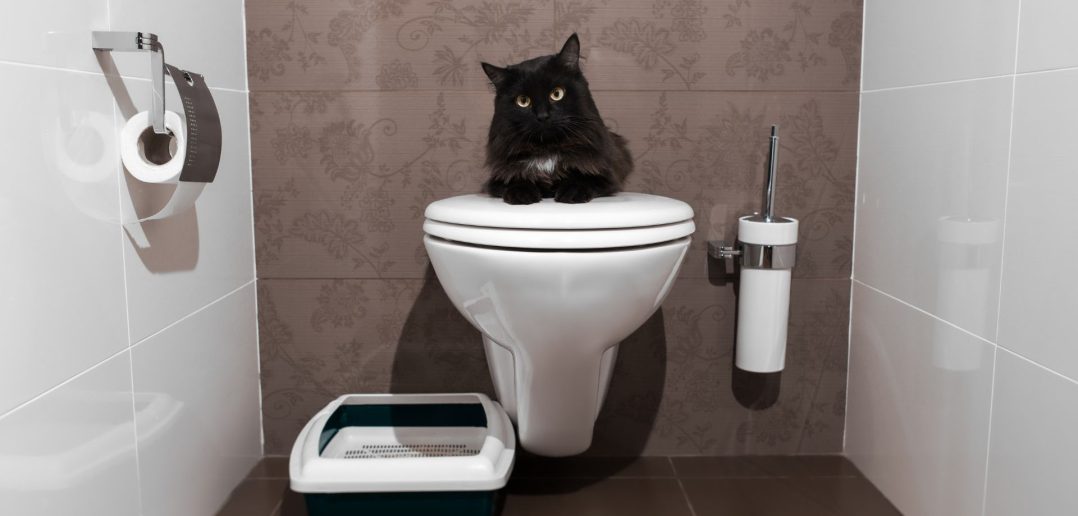Is Your Cat Ready for Toilet Training?
Rebecca Rescate offers up the following 5 ways you can tell…
At the end of a long day, who really wants to sift through a messy litter box? Certainly not me. Up until now, the litter-box has been a necessary evil, a small price to pay for our beloved companions. But not anymore. In fact, there’s an underground alternative designed for those of us who are ready to kick the litter habit: toilet training your cat.
Sounds complicated, right? Not at all. Although far from mainstream, cat toilet training is gaining momentum and cat owners across the country are beginning to embrace the trend. But before you toss that litter box into the trash, there are a few ways to tell if your cat is ready to take the leap into a litter-free lifestyle. Think Fluffy has what it takes? Read on.
1. Your cat is already litter-box trained.
OK, I know what you-re thinking: “Of course my cat knows how to use the litter-box!” But the simple fact is, cats that already know how to use the litter-box can be reconditioned to use the toilet instead. That’s because cat toilet training utilizes your cat/s natural instincts to bury their waste to hide their scent from predators. During the toilet training process your cat will learn to put its waste in water instead of in litter. Once your cat makes this transition toilet training becomes a breeze and – voila! Your cat is successfully potty trained!
2. Your cat is eager to please you.
Does your cat love making you happy? Whether she leaves the occasional “gift” on your doorstep or offers a warm nuzzle while you’re reading, cats who are eager to please are the purr-fect candidates for toilet training. After she learns that using the toilet pleases you, she’ll be happy to oblige.
3. You have trained your cat to do something in the past.
Does your cat come when you call him? Believe it or not, simple actions like responding to a voice command can help lay the groundwork for the toilet training process. After all, if your kitty already knows how to “follow the leader,” toilet training will be a breeze.
4. Your cat is healthy.
This one might seem like a no-brainer, but healthy cats have a much easier time jumping up onto their new throne. Illnesses like arthritis or urinary tract infections can affect their ability to learn how to use the toilet, so sick kitties should stick to the litter box.
5. You know your cat.
Can you tell when your feline friend is having a rough day? If you’re like many pet owners, you’re probably very in tune with your cat’s feelings. This unique bond works as a positive force during the toilet training process. How? Cats will use body language to tell you if they are comfortable with a particular training step. When you pick up on these signals, both of you can work together to achieve a relaxed training pace. You’ll both feel more satisfied when you work as a team!
Rebecca Rescate is the creator of the CitiKitty Toilet Training Kit. She has helped thousands of cat owners pursue their dreams of a litter-free life with their beloved felines. Visit her site to find out more about CitiKitty!





5 Comments
Very realistic approach and valuable tips. But I guess that every cat is different and one of the eldest I had, a female Siamese, was never taught how to use the toilet until one day after coming back from a long weekend I discover her sitting on the edge of the toilet seat and peeing. Her two litter boxes were of course saturated and she was always very picky on the quality of the sand, it always had to be dry and of a specific brand. So I guess that she had found an alternative to keep her feet dry.
The only explanation I can give was that she was observing everything and was trying to imitate people around her.
Pet Cares last blog post..Choosing The Perfect Dog Food Bowl And Water Dish
This is a really great blog!
There is a new Pet Site and everyone is joining up, it’s called http://www.dogpawfile.com I just wanted to let everyone here know about it! It’s great fun!
Cats that are accustomed to being let outside, or that want to get into their home, may learn to open windows and doors. They are capable of learning different routes for entry and exit; for instance a cat might find the window in its owner’s kitchen easier to open to exit the house, but to get in, they might have to use the screen door in the backyard
I had spent over five years scooping that litter box. After less than five weeks I had her toilet trained. This was the best investment I ever made.
I’ve tried, but never been successful toilet training my cats. It would more than be worth it if I could. I have to constantly scoop their litter – and if I miss a scooping, they sometimes go elsewhere in protest. Ugh.